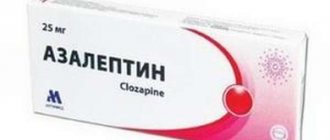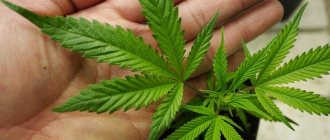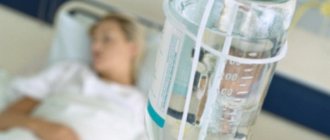Alcohol withdrawal syndrome is a common condition that occurs against the background of alcoholism. The difficulty of treating the patient is aggravated by the fact that the patient does not realize the severity of his situation and believes that he can stop drinking whenever he wants. As soon as the usual doses of alcohol stop entering the body, its physical condition and psycho-emotional background sharply deteriorate. Such conditions require hospitalization in a drug treatment clinic.
Pathophysiology
Most people with alcoholism are vulnerable to the consequences of abruptly stopping long-term ethanol consumption. However, withdrawal does not typically occur in the general population because most people drink occasionally, which does not lead to the sustained high blood alcohol concentrations needed to cause withdrawal symptoms.
Withdrawal symptoms occur because alcohol is a central nervous system depressant. It simultaneously enhances inhibitory tone (via modulation of gamma-aminobutyric acid activity) and inhibits excitatory tone (via modulation of excitatory amino acid activity). Only the constant presence of ethanol maintains homeostasis. Abrupt cessation masks adaptive responses to chronic ethanol use, leading to central nervous system hyperactivity.
Gamma-aminobutyric acid (GABA) is the main inhibitory neurotransmitter in the brain. Chronic use of ethanol causes insensitivity to GABA, so that more inhibitor is required to maintain constant tone.
As alcohol tolerance develops, the individual remains agitated by the alcohol buildup in the body, which usually leads to a painful state of lethargy (slowness, lethargy, fatigue, or even coma). Cessation of alcohol consumption or reduction from chronically elevated concentrations leads to a decrease in inhibitory tone and unregulated excess arousal.
Alcohol withdrawal - what is it?
Symptoms and treatment, of course, are interrelated and are very diverse. In this matter, everything depends on the characteristics of the patient’s body, the degree of destruction of his internal organs and the stage of alcoholism. This disease is diagnosed exclusively in addicted people and is one of the main signs of alcoholism.
What is the nature of this phenomenon? The brain is filled with a variety of chemical structures - neurotransmitters, which are necessary for communication between the cells of the organ. Some of them, reacting with the cellular proteins of neurons, increase their activity, while others, on the contrary, suppress their performance.
Withdrawal symptoms
Withdrawal syndrome in chronic alcoholism is caused by hyperactivity of the central nervous system and may include, after reducing or stopping alcohol consumption, the following symptoms:
- insomnia;
- anxiety;
- gastrointestinal disorder;
- anorexia (eating disorder);
- headache;
Insomnia - diaphoresis (excessive sweating);
- heartbeat;
- autonomic hyperactivity (sweating, tachycardia);
- increased hand tremors;
- nausea or vomiting;
- transient visual, tactile, auditory hallucinations or illusions;
- psychomotor agitation.
Alcohol withdrawal is the body’s reaction to excessive drinking. The severity of withdrawal can be divided into three stages. Stage I symptoms are mild and usually not associated with abnormal vital signs. Stage II symptoms are more intense and are associated with abnormal vital signs (such as increased blood pressure, breathing, and body temperature). Stage III includes delirium tremens or seizures. If treatment is ignored, stages II or III can progress rapidly.
Symptoms are usually present within six hours of stopping drinking and often develop while patients still have significant levels of alcohol in their blood. If withdrawal does not progress, these results resolve within 24 to 48 hours. Specific minor withdrawal symptoms in alcoholism are usually repeated from one case to another.
Cramps usually occur within 12 to 48 hours after the last alcoholic drink, but can occur after two hours of abstinence. Attacks occur predominantly in patients with a long history of chronic alcoholism. Single or frequent convulsions occur.
Convulsions may be of an epileptic nature. Benzodiazepines, Phenobarbital and Propofol can be used to treat seizures of an epileptic nature. Studies have shown that phenytoin is not effective in treating withdrawal seizures and the drug should not be used for this purpose.
Alcoholic hallucinosis is not synonymous with delirium tremens. Alcoholic hallucinosis refers to hallucinations that develop within 12-24 hours of abstaining from alcohol and usually resolve within 24-48 hours. Hallucinations are usually visual, although auditory and tactile hallucinations may also occur. Patients know that they are hallucinating and are often upset about it. However, unlike delirium tremens, alcoholic hallucinosis is not associated with global clouding of the sensorium (hearing, vision, smell), but only with specific hallucinations. Vital signs are normal.
Other signs
However, the truly severe course of the syndrome is characteristic of the third stage of addiction. Suffering from harmful attachment, the patient ceases to see greater values than alcohol. That is why, when you give up alcohol, all of the listed symptoms are significantly aggravated, pronounced disorders in coordination of movements, cold sweating, pallor and even bluish skin, and serious pathologies of the cardiovascular system occur.
As for external signs, chronic alcoholics, as a rule, are identified by an overly thin, pointed face. In stage three addiction, alcohol withdrawal may last longer than 5 days, and its consequences may well be mental disorders.
This syndrome can have various forms:
- neurovegetative - a standard pathology that involves the occurrence of all the main symptoms: lethargy, insomnia, fatigue, asthenia and others;
- somatic - with this pathology, predominantly somatic symptoms are expressed, for example, vomiting and nausea, diarrhea, disorders of the heart;
- cerebral - pronounced neurovegetative disorders are noted, which are accompanied by migraines, epileptic seizures, and fainting states;
- psychopathological - the symptoms are dominated by mental disorders: suicidal mood, feelings of guilt, hallucinations, phobias, insomnia, anxiety, depression.
Treatment
If a patient has convulsive seizures, treatment for alcohol withdrawal is carried out in a hospital under round-the-clock medical supervision. In order to carry out detoxification measures, the patient is given an enema that cleanses the blood, and given activated carbon or other adsorbents (Polifepam, Smecta) to drink. After this, the specialist prescribes intravenous therapy:
- sodium chloride;
- glucose 5% with vitamin B1;
- vitamins B and C.
Under the control of electrolyte levels in the blood, patients are prescribed sodium and magnesium, as well as potassium. Diazepam is administered intramuscularly to relieve restlessness and anxiety. The dose of the drug is selected individually for each patient. Patients often experience heart problems, swelling and shortness of breath, and increased blood pressure. Relief of alcohol withdrawal syndrome is accompanied by normalization of the sick person’s sleep; for this, he is prescribed Phenazepam and Tizercin. Saline solutions are administered with diuretics. Nutrition is provided through intravenous medications.
Diagnostic measures
The diagnosis is made based on signs of the disease during examination, questioning and studying the patient's medical history. The doctor determines the possible severity of the pathology in order to be able to prescribe effective treatment. If in doubt, the following diagnostic techniques can be prescribed:
- Laboratory tests for the presence of metabolic products of ethyl alcohol in the blood and urine;
- PCR and ELISA for viral hepatitis C, B;
- Test for HIV infection;
- ECG, ultrasound of the peritoneal organs;
- EEG, radiography of the skull in several projections;
- Fluorography.
Daytime tranquilizers
Treatment may include one or more medications. Benzodiazepines are anti-anxiety drugs used to treat withdrawal symptoms such as restlessness and poor sleep, and to prevent seizures and delirium (a mental disorder ranging from confusion to coma). These are the most commonly used medications during the detoxification phase. They should be used with caution as they are addictive.
If the withdrawal syndrome is accompanied by convulsions, the psychiatrist prescribes treatment with the tranquilizer Grandaxin. Some people drink too much and experience symptoms of anxiety, depression or stress. People suffering from depression, anxiety or other similar problems can also use Grandaxin for treatment. A drug from the group of benzodiazepine derivatives eliminates forms of autonomic disorders. Grandaxin removes mild neurotic disorders. It is prescribed for symptoms of fear, anxiety, and general psychological discomfort. Grandaxin has moderate stimulating activity and is widely used as a sedative for heart pain.
Options for the course of pathology
Alcohol withdrawal symptoms can manifest in several variations:
- Neurovegetative disorders are the most common manifestations of the disease; they represent the basis on which other signs of the disease are superimposed. In this case, a person’s sleep is disturbed, his appetite disappears, his blood pressure jumps, his face swells, his hands tremble, and his mouth becomes dry.
- Cerebral disorders in which dizziness, loss of consciousness or epileptic seizures occur, migraines develop, and sensitivity to loud sounds increases.
- Somatic disorders are characterized by the manifestation of symptoms of disturbances in the functioning of internal organs. A person may have yellow skin, develop bloating and diarrhea, arrhythmia, pain in the heart and abdomen.
- Mental disorders develop in the form of anxiety, fear, sleep and spatial orientation disorders, visual and auditory hallucinations. In some cases, panic attacks and suicidal thoughts may occur.
Regardless of how alcohol withdrawal syndrome proceeds, it will always be accompanied by mental and thinking disorders.
Medicines that relieve cravings for alcohol
Not everyone will take medication to help them abstain from drinking. However, some people take medications to curb the cravings for alcohol. There are several prescription medications on the market that are used to help people achieve and maintain abstinence. The most common are: Proprothene 100, Colme (forms an allergy to alcohol, symptoms appear that frighten the alcoholic). When treating alcohol dependence, take the drug Metronidazole. Topomax also inhibits drinking by inhibiting dopamine receptors. The antigen is used for months and slowly changes the attitude towards alcohol. If a person independently decides to give up alcohol, but finds it very difficult to abstain, he can get a prescription for one of these drugs from a psychiatrist.
Diagnostics
The syndrome is identified by the totality of symptoms that the patient has at the time of contacting a specialist. An extremely important criterion in determining the diagnosis is the desire to drink alcohol during the abstinence period.
To accurately identify the stage of the pathology, the narcologist must clarify how long and in what volume the patient took alcohol, as well as the intensity of his craving for alcohol the day after consumption. In addition, you should find out whether the patient feels guilty for excessive drinking of strong drinks. To identify physiological signs of alcohol withdrawal, a thorough examination of the patient is carried out.
Since the syndrome is considered one of the manifestations of a severe form of addiction, differential diagnosis is necessary not only with other pathologies that appear due to the use of psychotropic substances, but also with anxiety and depressive disorders.
Different Treatment Approaches
If the binge is severe, then the person must be hospitalized under round-the-clock supervision of doctors on duty. After doctors bring the addict out of abstinence, it is necessary to explain to him what happened to him.
- Alka-Seltzer and Antipohmelin - drugs accelerate the removal of breakdown products of ethyl alcohol from the body.
- Relief of alcohol withdrawal in 1-2 sessions leads to stable sobriety for a long time.
- Acupuncture affects a person’s energy and eliminates cravings for alcohol in 7–10 sessions.
- Electropuncture also helps eliminate cravings for alcohol in 5–7 sessions. The person feels that he no longer needs alcohol.
- ICT - intracranial translocation consists of a special neurophysiological effect on certain lobes of the brain.
If the behavior of an alcoholic threatens the lives of relatives, then it is necessary to remove sharp objects and call a psychiatric care team. The first symptoms of delirium tremens: hallucinations, anxiety, shuddering, frightened eyes, seeing and hearing things that are not really there.
Withdrawal syndrome or hangover?
It is extremely important to distinguish what alcohol withdrawal is and how it differs from a regular hangover. A hangover occurs in most people who drank alcohol the day before. The reason for its occurrence is general intoxication of the body with the breakdown products of ethanol, but this condition passes quite quickly - within a few hours, maximum - one day.
What is it? The state of alcohol withdrawal, or withdrawal syndrome, is a whole complex of disorders that manifests itself in the form of psychosomatic and neurological abnormalities.
How long this condition lasts and its severity will directly depend on the duration of alcoholism in the patient and the characteristics of his body. On average, this figure varies from 3 to 5 days. This situation of the patient poses a threat to him and the people around him.
Tips on how to stop drinking
If a person is abstaining from drinking for a day or more, here are some tips that may help.
- Find other ways to relax. Many people believe that alcohol is a way to relax. But in fact, it excites the nervous system. After giving up alcohol, a person needs to find other joys in life. Simple things will help: a hot bath, yoga, exercise, faith in God, meditation and relaxation.
- Fighting insomnia. Good sleep is the key to a successful day. Drinking alcohol at night only excites the nervous system. Due to insomnia, many lose strength. There are several treatments and medications that can help with insomnia, including motherwort and valerian root. It is necessary to go to bed on time. The most optimal time is 22:00. Peppermint tea, milk, apple and vitamins B1, B6, B12 can also help with insomnia.
- Find alternative activities. The best way to abstain is to engage in activities that are incompatible with drinking and much more enjoyable. Sports activities. Website creation. Writing an article or book. Knitting. Anything a person truly loves more than alcohol is a great way to abstain.
- Use behavioral tools. You need to learn not to remember negative events in life. This may help you stop drinking. You should always remember that a person is the master of his mind - if there is no way to control the events around him, then you can react to them differently.
Note: If a person has been drinking heavily for a long time, it may be necessary to gradually reduce their drinking levels to avoid potentially dangerous withdrawal symptoms.
Complete abstinence is the only cure for alcohol addiction. The most common mistake is underestimating the amount of specialist help required to stop drinking alcohol: psychologist, psychotherapist, psychiatrist, narcologist. Patients who try to limit their alcohol consumption for a period of time and fail to do so will soon realize that they have already developed an addiction. It is necessary to motivate addicts - to try to abstain.
First aid
Treatment at home should be limited, especially in the use of medications. Their unreasonable use can lead to unpredictable and undesirable consequences. Only a doctor can determine the optimal treatment with medications.
Independent first aid measures are aimed at reducing intoxication. To do this, gastric lavage is performed. The patient must drink a large volume of warm water, after which he is induced to vomit.
Similar actions are performed until the moment when clean water comes out instead of vomit. Then you need to take regular activated carbon with a small amount of liquid. The dose is calculated as follows - 1 tablet per 10 kilograms. It binds toxic substances well and promotes their removal from the body.
It is important to drink plenty of fluids to prevent dehydration. It is best in the form of fortified drinks: fruit drinks, compotes, tea with healthy fillings. Most of all, the body needs B vitamins - B1 and B6, and C. Thanks to this, a large number of toxins and breakdown products are eliminated through the kidneys.
To normalize the mental state in home treatment, some herbal decoctions are used - chamomile, motherwort. They have a slight sedative effect. If headaches occur, mild painkillers can be used. Other medications should not be given without consulting a doctor.











